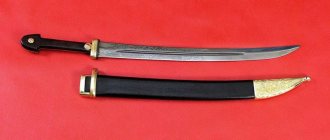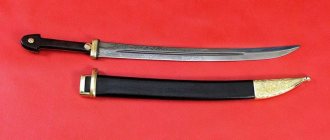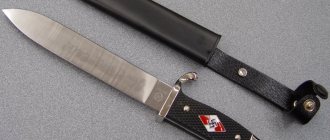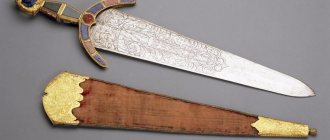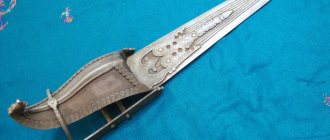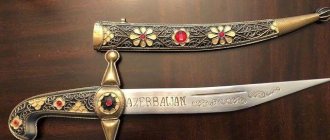A dagger is a combat knife with a pronounced edge, designed for stabbing and stabbing. The history of daggers dates back to the prehistoric era; they are still used in close combat in army formations. Many ancient cultures used decorated daggers for ritual and ceremonial purposes. The distinctive shape and historical use made the daggers symbolic and iconic.
Over the years, the term has been used to describe a wide range of stabbing knives, including single-edged knives such as the European daga or Persian pesh-kab, and some with no blades at all, such as the Renaissance stiletto. However, at the moment, daggers include products with a short and sharp blade, a central rib or fuller, and (usually) a double-edged blade with sharpening along the entire length.
Most daggers have a full guard to prevent your hand from slipping onto the sharpened blades. Another distinctive feature of modern daggers is that they are designed to position the knife in a horizontal plane with a wrist grip, allowing you to slash left and right, as well as hit the enemy between the ribs with a piercing blow. The double-edged long blade allows for wide cutting strokes using a forward or reverse grip, while the sharp end of the blade makes it an effective thrusting weapon. This versatility distinguishes modern daggers from the more specialized daggers of the Middle Ages, such as the stiletto.
Early history
Just like battle axes, daggers evolved from prehistoric tools. During the Neolithic era, daggers were made from materials such as flint and bone and were used as weapons in the earliest period of human civilization. The earliest metal daggers made of copper appeared at the beginning of the Bronze Age, in the 3rd millennium BC, preceding the appearance of Bronze Age swords.
In prehistoric Egypt, daggers were decorated as ceremonial objects with gold hilts, and later even more ornately with a variety of designs. One of the early silver daggers had a blade with a central rib. Traditionally, some military and naval officers carried daggers as a symbol of authority; in modern times, soldiers still carry combat knives and bayonets. Copper daggers of the Minoan civilization were found at the excavations of Knossos (Crete).
In ancient Egypt, daggers were usually made of copper or bronze, while the nobility had golden weapons. In 1924, during the opening of Tutankhamun's tomb, two daggers were found, one with a gold blade, the other made of smelted iron. Iron ore was not found in Egypt, which makes the iron dagger rare, and shows that the iron dagger was valued the same as the gold one. Analysis showed that its blade was made of an alloy in which most of the iron was, and it is believed that this iron was of meteorite origin.
One of the earliest smelted iron objects is a dagger, dating to before 2000 BC, found in a Hutt royal tomb dated to 2500 BC, and the context of the find shows that the dagger was of very high value. The dagger consisted of an iron blade and a gold handle.
Handle Features
Bone or metal plates were used to make the handle. The nails on the handle served as beacons for the hand, and they also held the lining. The tactile sensation made it possible to correctly pull the blade out of its sheath at night.
Features of the handles of the Caucasian dagger include the following points:
- the overhead handle was attached to the blade with washers or rivets;
- the mounting handle was also additionally secured with rivets;
- There were also metal handles, which could be solid or consist of several elements.
Antiquity
Craftsmen and blacksmiths of Iberia (modern-day Catalonia) produced a variety of high quality iron daggers and swords from the 5th to 3rd centuries BC, with designs and designs showing influences from Greek, Punic and Phoenician cultures. The exceptional purity of Iberian iron and complex forging techniques, including cold hammering, made it possible to produce double-edged blades of excellent quality. Advanced items such as folding knives can be found among artifacts from many Second Iberian Iron Age burials, as well as in Roman Empire excavations throughout Spain and the Mediterranean. Iberian infantry were armed with several types of iron daggers, most of which were a shortened version of the double-edged sword, but true Iberian daggers had three-edged blades. Iberian swords and daggers were later adapted by Hannibal and his Carthaginian armies. The Lusitanians, a pre-Celtic people, dominated the northwestern lands of Iberia (most of modern Portugal), and successfully held off the Roman Empire for many years with a variety of innovative tactics and light weapons, including. spears with iron tips and daggers modeled on the Iberians. During the Roman Empire, legionnaires were armed with the pugio dagger (from the Latin “pugnō” - “fight”) - a double-edged stabbing dagger with a blade about 35 cm long. The design and manufacturing technology of the pugio were taken directly from Iberian daggers and short swords; the Romans even adopted the three-edged blade, which they called the parazonium). Like the gladius, the pugio was most often used for stabbing. In the closest combat possible, the pugio was the Roman soldier's "weapon of last resort." Outside of combat, the pugio was used as a regular knife.
Specific device
All Caucasian combat daggers had common features. Let's look at them in more detail:
- The handle of the products has an expanded base, a narrow handle and a cap-shaped head.
- Almost all blades have fullers.
- The blades of the daggers taper to the tip and the blade is double-edged.
- The blades are hung with an elongated tetrahedral tip.
- The handle could be made of various materials.
- The sheath was made of wood and covered with leather.
- The total length of the products ranged from 40 to 75 cm, while the length of the blade could be 30-62 cm.
Ossetian
The Ossetian dagger has a double-edged blade with a number of fullers from 1 to 4. The surface of the blade was decorated with a pattern of climbing plant stems. The sheath of the product was made in black. Today this product is an element of the national costume. They can be up to 1 m long.
Ossetian daggers.
Georgian
Georgian daggers have their own distinctive features. The general dimensions of the product are the same as for all mountain blades. The general appearance of the dagger resembles a sharp wedge. The hilt of a Georgian dagger is its distinctive part. It is equipped with hooks with hemispherical caps and petal-shaped edges.
The blade has a significant mouth with a clip. Triangular protrusions are visible at the end. The scabbard and hilt have a silver edging with floral patterns. They were decorated with engraving and gilding. There is a welding plate along the central part of the blade.
Georgian items.
Armenian
The distinctive features of Caucasian daggers are hidden in individual elements. The handle in the pommel area resembles an elongated arch. Which has cutouts called interceptions. The head of the snag is made in the form of cones or circles.
The top of the scabbard merges with the frame in the form of a triangular protrusion. The tip is also connected. There are scalloped tulips at the ends, and the protruding part is given the shape of an arch. A floral pattern with Armenian letters is applied to the handle.
Armenian products.
Dagestan
The products of Dagestan masters are revered as the best. The blade is not very long, fits well to the handle and for convenience has a fuller arrangement - the right one is slightly higher than the left one. A pattern in the form of welding metal is applied to the blade.
The area between the sharp edge of the blade and the fuller can be blued. The handle at the end is narrower and becomes similar to the shape of a bebut. The snags are made like small pyramids. Traditionally, intermediate washers are not placed between the nails. Parts of the handle may have bone inserts with floral decoration.
Dagestan blades.
Middle Ages
The term "dagger" appears only during the Late Middle Ages, reflecting the fact that the dagger, well known in antiquity, virtually disappeared during the Early Middle Ages, being replaced by the sax (cutting knife).
The dagger reappeared in the 12th century as the "knight's dagger", or more accurately the crosshair dagger. It was used both as a tool and as a civilian weapon during the Late Middle Ages.
The earliest known image of a dagger with a crosshair, also called the "bas-relief of Guido", is located in the Grossmünster church in Zurich (1120). Many images of full-fledged daggers with crosshairs are found in the Morgan Bible (1240). Most of these daggers resemble miniature knives with guards and pommels similar to swords of this period. Some, however, do not have exact matches of shapes with swords, having, for example, pommels in the form of a lid, or a star-shaped pommel, also called “Burgundian heraldic daggers,” or guards and pommels with antenna-shaped shapes, reminiscent of the daggers of the Hallstatt era. Daggers with crosshairs were also preserved during the Renaissance.
The Old French term "dague" refers to a 13th century weapon, along with other terms such as poignal or basilard. The English term dagger has been in use since the 1380s.
During this time, the dagger was often used as a second dual weapon of self-defense in close combat. The knight's dagger evolved into the larger baselard in the 14th century. The baselard occupied an intermediate position between the short sword and the long dagger, and became popular as a civilian weapon. Hans Sloan (1660-1753) wrote a satirical song about the use of oversized baselards as a fashion accessory.
During the Late Middle Ages, knives with pronounced stabbing blades, such as the stiletto, became increasingly popular, and some stabbing daggers had no blades at all. This was a consequence of the proliferation of heavy armor, such as chainmail and plate, against which slashing was ineffective, and the main attacks focused on striking with a narrow blade in such a way as to pierce the chainmail, or hit the joints of the armor (or the cracks of the helmet visor). These later medieval weapons are sometimes classified by the shape of their hilts, such as the rondel dagger and ballok. The term dagger ("dagger") was coined at the same time as the Germanic equivalent dolch and dagen. In the German fencing school, Johannes Lichtenauer and his followers (especially Andreas Ligniser) taught dagger fencing.
These techniques resemble modern knife fighting in some aspects, but with a strong emphasis on thrusting, with a minimum of cutting and thrusting. In offensive actions, the standard attack usually used a reverse grip with the blade pointing downwards to increase the force of the blow and the penetrating ability of the blade. This was done primarily because the blade often had to pierce steel chain mail or plate armor in order to injure the enemy. The disadvantage of such a strike is that the strike can be easily blocked in various ways, most often by blocking with an unarmed hand, while striking with a weapon in the other hand. Another disadvantage was the reduction in effective striking distance with a reverse grip. After the use of armor began to decline, dagger fighting techniques evolved to the normal (forward) grip, while the reverse grip continued to be used to strike the enemy from the back while sneaking up.
Caucasian saber
Thanks to the excellent workmanship of the product and beautiful decor, the Caucasian saber was very popular. According to some researchers, the saber was the crown of the weapon art of the Caucasians. Such products appeared in the 12th-13th centuries.
A distinctive feature of the Caucasian saber was a thin blade with a length of 70-80 cm.
There was also a characteristic bend of the product. They did not weigh much, only 600 grams. The sharpening was done on one side, and the butt was also sharpened closer to the blade.
The products had fullers that reached almost one-fourth of the tip. The width of the notches could be different. An important characteristic of the Caucasian checker is considered to be a precisely adjusted balance. The sheath was made of wood and covered with leather.
They were attached to the shoulder or waist belt with special rings. Another important distinguishing feature of the product is that it was worn with the blade facing up. Thanks to this, the saber could be snatched with lightning speed in battle. This gave an advantage.
Caucasian checker.
Renaissance and early modernity
The dagger was a very popular weapon for fencing and self-defense during the 17th and 18th centuries in Spain, where it was called the daga. During the Renaissance, the dagger was used as part of everyday costume, and daggers were the only type of weapon that civilians were allowed to carry. In England, the terms poniard and dirk (dirk) appear in the late 16th - early 17th centuries, later pronounced as dork, durk (presumably in the manner of Low German, Danish or Scandinavian dolk, in turn derived from the West Slavic Tulich), in modern pronunciation dirk (dagger) appeared in the 18th century in Scotland.
Beginning in the 17th century, another form of dagger, the bayonet, and later the bayonet, was used to convert muskets and other long-barreled weapons into piercing weapons by attaching the bayonet to the barrel.
At the same time, very ornate daggers began to be made in India.
Making Caucasian daggers
Blacksmiths were revered in all nations and at different times. They kept their knowledge secret and passed it on to their descendants with special trepidation. Masters have always tried to improve their skills. The famous damask steel is proof of this.
It is produced using repeated hardening and forging. This production technology allows us to obtain a very durable blade. Making a Caucasian dagger always took a lot of time. Steel of the required quality was selected for the nal.
It must be pliable, stable and durable. Strong steel was used for the backing, soft for the base of the blade and resistant for the blade. The metals were placed in a furnace in strips on top of each other and then forged.
Then processing took place with a cutter to form grooves on both sides of the blade. The fullers are necessary to lighten the weight of the product, contribute to balancing and serve as a stiffening rib for the blade. Finally, the product was ground and polished.
Examples of Caucasian daggers.
Modernity
The First World War, with its positional battles in the trenches, brought back the relevance of daggers. They also replaced the sabers worn by officers, which were too long for the trenches. They were worn as part of a ceremonial uniform as a sign that the wearer was serving at the front. Daggers gained public recognition in the 20th century as uniform regalia during the fascist dictatorships of Mussolini in Italy and Hitler in Germany.
The revival of daggers as costume accessories and military equipment in Germany after the First World War provided the necessary impetus for the development of the metalworking center in Solingen. Daggers were used in uniform by other countries, such as Japan, but nowhere were they as common as in the military and political bodies of the Third Reich and Fascist Italy.
As a combat weapon, daggers were worn by infantry and special forces during the Second World War by the armies of all participants in the battles.
In addition to the armed forces, many daggers are not worn openly, but hidden under clothing. One of the most popular types of such daggers is the so-called. boot knife. It is a shortened dagger designed to be worn on the shin, usually by being fastened or tied to a boot or other footwear.
Why are knives with a double-edged sharpened blade prohibited?
A knife with a double-sided sharpening is a bladed weapon on the territory of the Russian Federation. In our country, double-edged knives are completely prohibited. This even applies to models with a blade less than 50.0 mm. This is due to the GOST regulations, which determine the circulation of dagger-type bladed weapons.
Regulatory documents regarding travel and cutting tools have a clause that states that it is inadmissible to produce knives for cutting and skinning with double-sided sharpening. Thus, the army of dagger fans will be disappointed, since in Russia, the blade spine can be sharpened by 1/3 or 2/3, taking into account the type and purpose of the weapon.
Previous
Kitchen knivesKnife Tsai Dao - chef from China
Next
Knives Stationery knife: types, care, selection rules
Notes[edit]
- State v. Martin, 633 S.W.2d 80 (Mo.1982): This is the dictionary or popular definition of dagger and has been used to describe everything from an ice pick to a folding knife with a sharp blade as a "dagger." '. The Missouri Supreme Court used the popular definition of "dagger" from Webster's New Universal Dictionary ("a short weapon with a sharp point, used for striking") to rule that an ordinary sharpened knife with a four to five inch blade constitutes a dagger" under criminal law. Missouri Code.
- ↑
California Penal Code 12020(a)(24): “Dagger” means
a knife or other instrument,
with or without a shank, that
can be used as a piercing weapon
that is likely to cause serious bodily injury or death. The state of California and other jurisdictions have taken advantage of the popular definition of a dagger to classify items ranging from a pointed kitchen knife to a tent peg as a “dagger” under the law. - ↑
Burton, Walter E.,
Knives For Fighting Men
, Popular Science, July 1944, Vol.
145 No. 1, p. 150: A dagger is classified as a type of combat knife
, while
a combat knife
is a knife
specifically designed for military use
, and therefore only certain types of daggers designed for military use are considered combat knives.
Thus, a common dagger intended for sale and civilian use is just a combat knife, while the US Army M3 Trench Knife is both a combat knife and
a combat knife. - Emerson, Robert L., Legal Medicine and Toxicology
, New York: D. Appleton & Co. (1909), p. 80 - ^ abc Cassidy, William L., The Complete Book of Knife Fighting
, ISBN 0-87364-029-2, ISBN 978-0-87364-029-9 (1997), pp. 9–18, 27–36 - ↑
Draper, Frank W.,
A Textbook of Forensic Medicine
, Philadelphia: WB Saunders & Co. (1905), pp. 341–343 - Gross, Hans, Criminal Investigation: A Practical Textbook for Magistrates, Policemen and Barristers
, London: Sweet & Maxwell (1949), p. 185 - Harding, David and Kann, Jefferson (eds.), Weapons: An International Encyclopedia since 5000 BC.
to 2000 AD , The Diagram Visual Group, New York: St. Martin's Press/Macmillan, ISBN 0-312-03950-6, ISBN 978-0-312-03950-9 (1990), pp. 32–33 - Goddard, Wayne, The Miracle of Knifemaking
, Iola, WI: Krause Publications, ISBN 1-4402-1684-3, ISBN 978-1-4402-1684-8 (2011), pp. 50, 131-132. - ↑ New Werner Twentieth Century, Encyclopdia Britannica edition
, volume 6, Akron, OH: The Werner Co. (1907), p. 669 - Dagger law and legal definition
- ↑
Sheridan, Alison,
Beaker period copper dagger blade from the River Silis near Ross Lough, County Fermanagh
, Ulster Journal of Archaeology, Vol. 56 (1993), pp. 61–62. - C. Michael Hogan, Knossos fieldnotes Modern Antique (2007)
- Iorwerth Eiddon Stephen Edwards, Cyril John Gadd, Nicholas Geoffrey Lemprier Hammond, 1970
- Burton, Richard F. (1884). Book of the Sword. Piccadilly: London Chatto & Windus. paragraph 80.
- Jay Cassell (2007). Peter J. Fiduccia (ed.). The Army of Tutankhamun: Battle and Conquest During the Late Eighteenth Dynasty of Ancient Egypt
. John Wiley and Sons. paragraph 77. ISBN 978-0-471-74358-3. - ↑
Anderson, George (1 March 2010). "The Dagger of King Tutankhamun". INCOSE Chesapeake Chapter. Archived from the original on October 8, 2018. Retrieved June 5 +2016. History is replete with eyewitness accounts of meteors falling from the sky and hitting the earth. Additionally, there are consistent records of the metal being recovered from meteorite debris and is often described or labeled as meteoritic iron. - Comelli, Daniela; d'Orazio, Massimo; Folco, Luigi; and others. (2016). "Meteor origin of Tutankhamun's iron dagger". Meteoritics and Planetology
.
Wiley Online. 51
(7):1301–1309. Bibcode: 2016M&PS...51.1301C. DOI: 10.1111/maps.12664. "Early View (online version of entry published before inclusion in print edition)." - Panko, Ben (2 June 2016). "Tutankhamun's dagger made from an ancient meteorite". The science
. American Association for the Advancement of Science. Retrieved June 5 +2016. - Robert Raymond (1986). From the Fiery Furnace: The Impact of Metals on Human History. Penn State Press. paragraph 61. ISBN 978-0-271-00441-9.
- ^ abcd Wise, Terence, Armies of the Carthaginian Wars, 265–146 BC
, London: Osprey Publishing Ltd., ISBN 0-85045-430-1, ISBN 978-0-85045-430-7 (1982), pp. 20–21 - Kay, Simon (Professor), Phoenicians, Carthaginians and Romans in southern Iberia Archived 2011-09-07 on the Wayback Machine
, Swan Hellenic on Digital Library and Archive, 30 June 2011, retrieved 2 August 2011 - De Fontcuberta, Eduardo A., Bandolero Blade
, Tactical-Life.com, tactical knives (September 2010), retrieved August 13, 2011 - Sir William Smith (1898). Frances Ware Cornish (ed.). A Concise Dictionary of Greek and Roman Antiquities. Murray. paragraph 66.
- ↑
Underwood, Richard (1999)
Anglo-Saxon Arms and War
Stroud, England: Tempus, ISBN 0-7524-1910-2, p. 70. - Gale, David (1989) Seax
in
arms and war in Anglo-Saxon England
Oxford, England: Oxbow ISBN 0-947816-21-6 - Capwell, page 28 and Thompson, page 25. Note that the term "quillon" is a modern invention, although it is commonly used
- Christopher Gravett (2007). Knight
. Penguin. paragraph 17. ISBN 978-0-7566-6762-7. - Daniel Gutscher, Das Grossmünster in Zurich
(1983), 120-121, 214-215. - See Thompson, page 10 and Peterson, plate 25, for good examples of this type in the Museum of London.
- See Capwell pp. 28, 122-123, Thompson pp. 24-25, and Peterson plates 26-29.
- Peterson plate 46 and Dean p.96, no. 100
- Thompson, Logan (1999). Daggers and bayonets. United Kingdom: Spellmount ltd. paragraph 24.
- prenegarde prenegarde, thus bere I myn baselard
ed. Pickering 1836. - French, George Russell (1869). Catalog of Antiquities and Works of Art, Volume 1. London: Harrison and Sons. paragraph 184.
- Egerton Castle (2003). Schools and Masters of Fencing: From the Middle Ages to the Eighteenth Century
. Courier Dover Publications. item 246. ISBN. 978-0-486-42826-0. - Steve Shackleford (2010). The Blade's Guide to Knives and Their Values
. Krause Publications. item 246. ISBN. 978-1-4402-0387-9. - Jason Vale (2006). Medieval and Renaissance dagger combat
. Paladin Press. paragraph 16. ISBN 978-1-58160-517-4. - Thompson, Logan (1999). Daggers and bayonets. United Kingdom: Spellmount ltd. paragraphs 22, 23,24.
- Chambers, John W., OSS Training in National Parks and Service Overseas during World War II,
Washington, D.C., U.S. National Park Service (2008), p. 191: Fairbairn reportedly participated in hundreds of street fights during his twenties career in Shanghai, where he organized and led a special anti-riot squad. Most of his body - arms, legs, torso and even palms were covered with scars from knife wounds in those fights. - ↑
Walker, Greg,
Battle Blades: A Professional's Guide to Combat/Combat Knives
, Boulder, Colo.: Paladin Press, ISBN 0-87364-732-7 (1993), p. 77 - Alexander, Joseph H., Edson's Raiders: The 1st Marine Battalion in World War II
, Annapolis, MD: Naval Institute Press, ISBN 1-55750-020-7 (2001), p. 67 - Sankey, E. B., From the Old Breed: In Peleleiu and Okinawa
, Presidio Press, ISBN 978-0-89141-919-8 (2007), pp. 21-22. - McCarthy, John (2008). "The Revived World War II Naval Raider Stiletto." Raider Patch (USMC Raiders Association).
- Steele, David (1988). "Shoefighting with a knife." Black belt
.
Active Interest Media, Inc. 26
(4): 48–51. - Guido Rosignoli (1987). The Illustrated Encyclopedia of 20th Century Military Insignia: A Comprehensive Guide to the Emblems, Patches, and Decorations of the World's Armed Forces
. Stanley Paul. paragraph 44. ISBN 978-0-09-172670-6. - David Gray (2006). The story that was never told
. Lulu. p. 87. ISBN 978-1-4116-1703-2. - Dickens, Charles (1841). Barnaby Rudge: A Tale of the '80s Troubles
. London: Chapman and Hall. p. 203. ISBN 0-14-043728-2. - ^ab Thompson, Logan (1999). Daggers and bayonets. United Kingdom: Spellmount ltd. paragraph 54.
- Edwards, -ethene (1990). "Images of steel." Blade Magazine
.
27
(4): 40–43. - "ABS Test Rules and Guidelines for Master Smith Rating" (PDF). Archived from the original (PDF) on 2018-10-03. Retrieved March 12, 2011.
- "The difference between a knife and a dagger". Retrieved May 12, 2022.
Links[edit]
- Capwell, Dr. Tobias. World Encyclopedia of Knives, Daggers and Bayonets
. House of Hermes. Leicestershire 2011.. - Dean, Bashford. Catalog of European Daggers 1300–1800
. Metropolitan Museum of Art. NY. 1929 - Edge, David and Paddock, John Miles. The weapons and armor of the medieval knight - an illustrated history of weapons in the Middle Ages
. Crescent Books. NY. 1988 - Iorwerth Eiddon, Stephen Edwards, Cyril John Gadd, Nicholas Geoffrey Lemprier Hammond. Cambridge Ancient History
. Cambridge University Press. 1970 (ISBN 0-521-07051-1) - Peterson, Harold L. Daggers and Fighting Knives of the Western World
. Bonanza Books. NY. 1970 - Thompson, Logan. Daggers and bayonets - history
. Paladin Press. Boulder. 1999 - Vail, Jason. Medieval and Renaissance dagger combat
. Paladin Press. Boulder. 2006
Main characteristics
Special knives are designed for throwing, differing from ordinary ones in design. To make the weapon penetrate the target easily, the blade is made narrow, flat, and spear-shaped. The handle is flat, there are no stops, grooves for fingers, limiters, or pads. This reduces weight. The throwing variety has a handle that is lighter than the blade, which increases accuracy.
How Caucasian daggers were forged in the old days
Residents of the village of Amuzgi have preserved the knowledge of the ancient production of Caucasian daggers. Previously, the master devoted a lot of time to the blade. Processing was carried out up to 13 times. First, a package of three different steels was prepared, as described above.
And it was heated and then forged. The fillers were made using a special cutter.
The blade was hardened in water and polished to a shine.
Samples of Caucasian daggers made of Damascus steel were marked with a mark. After repeated forging, the steel gave off a blue color.
And of course an intricate pattern appeared. But blades made of damask steel were considered the most durable. Such a dagger could be bent almost in a circle, and then it took on its original form. After the fight, not a scratch remained on the blade.
Caucasian knives made of Damascus and damask steel.
Dagger scabbards
A blade case is an important thing. The typical material for their manufacture was wood. It was covered with genuine leather. Pieces of metal were used to decorate the scabbard. At the end of the scabbard there was a small ball, sometimes with a pointed top.
This element was used not only for decoration, but also for practicality. With the help of a leather strap, the dagger was located under the arm on the belt. If necessary, the owner of the product could always quickly remove it. There was a clip inside that protected the tip of the dagger.


